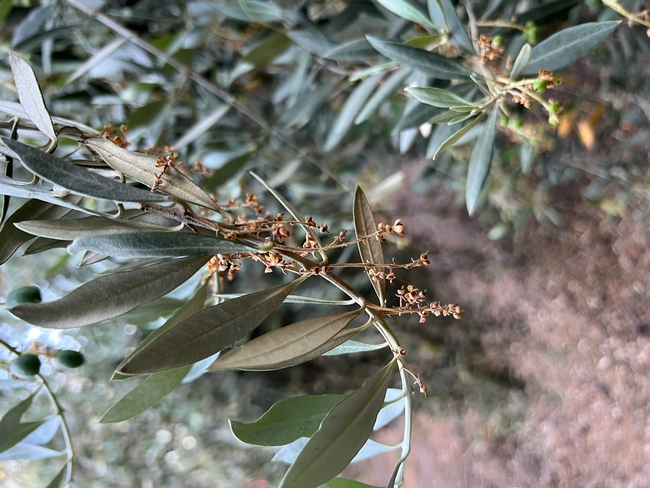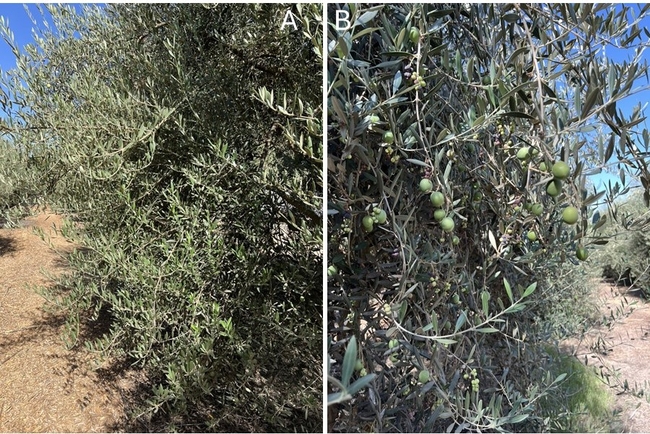The alternate bearing (AB) nature of olive is one of the top physiologically-driven challenges faced by olive growers. AB refers to the tree's habit of producing a heavy crop in one year followed by a light crop the next year. The heavy crop is referred to as the “ON crop,” which is characterized by large yields with small size fruit that may mature late and have reduced commercial value due to size. Conversely, the “OFF crop” has characteristically low yields with large sized fruit that may not be cost effective to harvest. AB adversely affects the consistency of the fruit supply, thus having a negative economic impact on every step within the production chain from farm to consumer. Because mitigation of AB can best be achieved by management of crop load, UC researchers have conducted recent studies evaluating the efficacy of a new chemical flower thinning strategy using naphthaleneactic acid (NAA) (Figure 1) applied at full bloom to only on side of the tree annually or biennially to reduce the severity of AB and maintain higher annual yields of commercially valuable size fruit.
There are currently four known mechanisms by which the ON crop reduces flowering and fruit number to contribute to AB of ‘Manzanillo' table olive orchards. The first mechanism of AB is the suppression of summer vegetative shoot growth by the current crop (Figure 1). Flowers and fruit on olive are borne on one year-old shoots; consequently, the vegetative growth in the current year provides the nodes at which inflorescences form in the subsequent spring. Research studies conducted in Tulare County California have demonstrated that the fruit's suppression of vegetative growth is irreversible after pit hardening. As a result, crop management strategies designed to reduce the current season's crop must be implemented by June to promote summer vegetative growth and increase return bloom the following year. The second mechanism of AB is inhibition of floral development (typically initiated in July) by the current season's crop. The third mechanism of AB is the inhibition of spring bud break. As a result of bud break inhibition, even floral buds that have formed may not open at bloom. Last, the current season's crop causes the abscission of floral buds. Since the OFF crop has an effect opposite to that of the ON crop, once AB is initiated in an olive tree, cycles of ON and OFF floral intensity and cropping are perpetuated by the opposing effects of high and low crop loads on these mechanisms.
Historically, olive growers have used NAA, a plant growth regulator, as a fruit thinning agent to reduce the current season's fruit load. Upon application, NAA is absorbed by leaves and developing fruit and is translocated to the peduncle where it incites an abscission layer at the point of attachment to the stem. As an olive fruit thinning agent, NAA is typically applied 12-18 days after full bloom, i.e., during fruit set. Treatments are made with an NAA ammonium salt product, such as Liqui-Stik Concentrate (Loveland Products) applied as a dilute spray (300-500 gallons per acre). Chemical thinning with NAA can be risky; too early an application may result in overthinning, whereas too late an application may not thin sufficiently. Additionally, hot temperatures (> 100°F) within one week of application may enhance the efficacy of NAA resulting in excess thinning. Due to the greater risk of spring heat waves in the south, chemical thinning has been more commonly utilized by table olive growers in the Sacramento Valley than in the southern San Joaquin Valley.
With support from the California Olive Committee, researchers have been evaluating the use of NAA at full bloom (rather than 12-18 days after bloom) as a crop management tool to reduce the severity of AB, which is measured as alternate bearing index (ABI) on a scale from 0 (no AB) to 1 (total AB, crop one year, no crop the other year). These studies tested a full bloom NAA application to one side of the tree with the goal of eliminating crop on one side of the canopy (Figure 2) while maintaining crop on the opposite side. Annual and biennial applications of NAA to just one side of the tree were compared. To implement the annual NAA application strategy in a commercial orchard, growers would apply NAA to one side of the tree at full bloom in year 1, then on the other side of the tree in year 2. In the biennial strategy for NAA application, there would be a year of rest (no treatment) between the application to one side of the tree in year 1 and the other side in year 3.
After 4 years of research, NAA application either annually or biennially at full bloom did not affect cumulative total yield. However, full bloom NAA applications to one side of the tree significantly reduced the severity of AB from near total AB (ABI = 0.94) for the untreated ON/OFF control trees by 20% when applied annually and 38% when applied biennially. The results indicate that annual total yields were more uniform from year to year, especially for trees treated biennially, which improves the economics of all steps in the production chain from farm to consumer.
In addition, both annual and biennial applications of NAA to one side of the tree at full bloom had positive effects on the yield of commercially valuable size (CVS) fruit (medium plus large) compared to the untreated ON/OFF control trees. Biennial NAA application at full bloom reduced the ABI for CVS fruit 43% compared to the untreated control trees, whereas annual NAA application at full bloom only reduced the ABI for CVS by 12.5%. Importantly, application of NAA at full bloom to one side of the tree biennially resulted in 40% greater cumulative yields of medium plus large fruit than untreated control trees, with annual treatment increasing yield of medium plus large fruit only 20%. The increased and more uniform yields of CVS fruit resulting from biennial NAA application at full bloom to one side of the provide growers with greater, more reliable annual income. Moreover, biennial application of NAA (once every three years) is half the cost of annual NAA application. Since NAA is applied to only one side of the tree at full bloom, for which total removal of the crop is desired, the risk of over thinning with NAA is eliminated in this strategy compared to the standard practice of applying NAA to the whole tree during fruit set. Whereas a grower must decide to treat once every three years based on floral intensity and without knowledge of the year's fruit set, the fact that only one side of the tree is treated lessens the effect of a subsequent poor set. The NAA standard practice provides the grower a window of 12-18 days after full bloom to evaluate fruit set when deciding to treat. If the grower sprays NAA according to the standard practice and set is subsequently negatively impacted (potentially by even NAA itself interacting with high temperatures), the whole tree will be affected.
The results of this research demonstrate the potential value of NAA applied at full bloom to shift the crop load to one side of the tree and then the other side biennially. This technique essentially creates a bearing and non-bearing side to each tree, allowing for unsuppressed vegetative growth on the treated side and documents the need for a rest period with no NAA application until year 3 to allow the tree to fully recover. Biennial application of NAA at full bloom to one side of ‘Manzanillo' olive trees successfully reduced the severity of AB and increased yields of commercially valuable size olive fruit better than annual application of NAA or the untreated ON/OFF control trees. The use of NAA at bloom to mitigate AB warrants further investigation. Researchers are also actively investigating the use of pruning 28 days after full bloom to only on side of the tree annually or biennially as a means of mitigating AB to achieve consistent yields of commercially valuable size fruit.
Attached Images:

